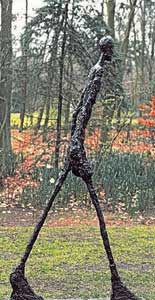Pierluigi Romani Neofigurativo Alto Per Giacometti
 SUMMARY OF PHILIPPE DAVERIO'S PRESENTATION
SUMMARY OF PHILIPPE DAVERIO'S PRESENTATION
"I must first of all admit that I am a man of the flatlands; half Lombardian and half Alsatian. There are two worlds that are abjectly undefined to me and they are the world of mountains and the world of the sea. They are so extraneous that through the years they have filled with profound mystery for me: I look at them through the eyes of one who sees these sites as the source of mysterious divinities. This is the site of the mysterious divinities that will help us understand Giacometti".
"It is fundamental to understand the bizarre culture that has developed here in the mountains, which was initially a culture that the Mediterranean almost completely ignored. The people of the Mediterranean looked at the people of the Alps with absolute disinterest. Then the destiny of the mountains changed to become a site of refuge, and later a site where goods were no longer transferred, but men were. In the sixth and seventh century the mountain was the bringer of civilization, while the sea was barbaric. Then came the development of the great monastic culture and remythicization. The Alps would become an infinite spider web stretching out in all directions. That is the reason why when Charles the Great decided to renovate the empire, a large part of the Carolingian strategies no longer centred on the Mediterranean, but were founded on the Alpine world which became the central point of contact".
"That is why you find the best testimonies to Carolingian painting in the Grisons and the area descending towards Trentino. Just think of the infinite game of macabre dances by Pinzolo, the ones in Bergamo, Zurich and those across the Alps. The Alps became a site with its own imagery. However, the mountain continued changing and at a certain point there was a crisis and its central role became less important leaving those who lived in the mountains with a sense of melancholy and frustration, and that is the other sensation that we always find in Giacometti's work. Giacometti must be reconnected to his origins, his true anthropological origins, the origins of those who lived and communicated with this mountain, these same fears and these same anxieties [...]".
"According to a somewhat unavoidable destiny, which is the destiny of mountain men: he spent the end of his life on a sad and terrible road in the town of Stampa in a sort of log cabin where he created the most beautiful sculptures of the twentieth century. He returned to the mountain as mountain men are prone to do ".



Yves Bonnefoy: "Did Giacometti realize that by venturing into the mountain he was going to run straight into his destiny? He was certainly aware of it subconsciously since he spent the beginning of his life with the profile of the tall mountains surrounding Stampa in front of him, delineated like absolutely extraneous and immeasurable space. (...) Giacometti began sculpting the human face in a material which could be considered as the mountain itself. He felt that it was the space of every existence. His sculpted busts challenge death, they are the unending portrayal of the act of understanding that he undertook as he left for Madonna di Campiglio on horseback with his old friend. (...) It is difficult to imagine that there is not some sort of providence that moves secretly in the depths of great artists' lives".